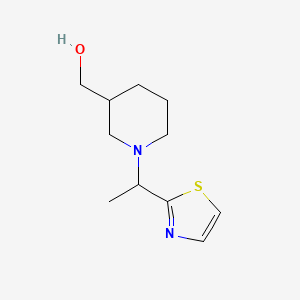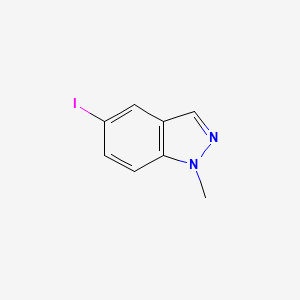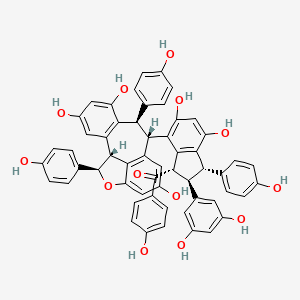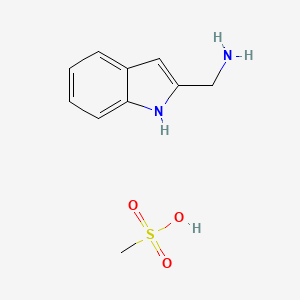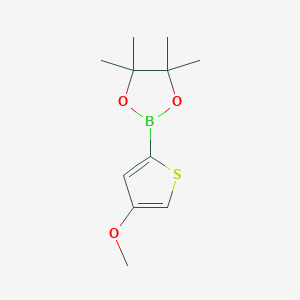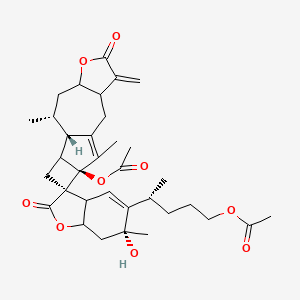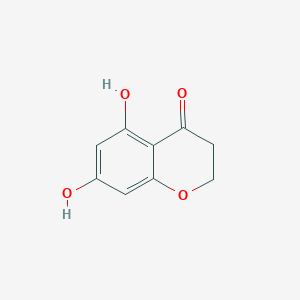![molecular formula C19H20FNO3 B3026791 (3R,4S)-3-[(2H-1,3-BENZODIOXOL-5-YLOXY)METHYL]-4-(4-FLUOROPHENYL)PIPERIDINE CAS No. 112058-85-2](/img/structure/B3026791.png)
(3R,4S)-3-[(2H-1,3-BENZODIOXOL-5-YLOXY)METHYL]-4-(4-FLUOROPHENYL)PIPERIDINE
概要
準備方法
合成経路と反応条件
パロキセチンヘミハイドレートの合成は、パロキセチンの基本的な化学構造から始まり、複数の段階を踏みます。このプロセスには、塩酸塩の形成とそれに続く結晶化が含まれ、ヘミハイドレート形態が得られます。 温度、pH、溶媒の選択など、特定の反応条件は、最終生成物の純度と収率を確保するために重要です .
工業生産方法
パロキセチンヘミハイドレートの工業生産は、同様の合成経路に従いますが、より大規模に行われます。 このプロセスは、効率とコスト効率を最大限に高めるように最適化されており、多くの場合、自動システムと厳格な品質管理対策が含まれており、一貫性と純度が維持されます .
化学反応の分析
反応の種類
パロキセチンヘミハイドレートは、以下を含む様々な化学反応を起こします。
酸化: 酸素の付加または水素の除去が含まれます。
還元: 水素の付加または酸素の除去が含まれます。
一般的な試薬と条件
これらの反応に使用される一般的な試薬には、過マンガン酸カリウムなどの酸化剤、水素化リチウムアルミニウムなどの還元剤、置換反応のための様々な求核剤があります。 温度、溶媒、触媒などの反応条件は、反応経路と収率を決定する上で重要な役割を果たします .
主要な生成物
これらの反応によって生成される主要な生成物は、使用される特定の試薬と条件によって異なります。 例えば、酸化はヒドロキシル化誘導体を生成する可能性がありますが、還元は脱酸素化化合物を生成する可能性があります .
科学研究への応用
パロキセチンヘミハイドレートは、幅広い科学研究への応用があります。
化学: 分析研究と方法開発における基準化合物として使用されます。
生物学: 神経伝達物質系や細胞シグナル伝達経路への影響について研究されています。
科学的研究の応用
BRL29060A hemihydrate has a wide range of scientific research applications:
Chemistry: Used as a reference compound in analytical studies and method development.
Biology: Studied for its effects on neurotransmitter systems and cellular signaling pathways.
Industry: Utilized in the development of new pharmaceutical formulations and drug delivery systems
作用機序
パロキセチンヘミハイドレートは、シナプス前ニューロンにおけるセロトニンという神経伝達物質の再取り込みを阻害することで効果を発揮します。この阻害により、シナプス間隙のセロトニンの濃度が上昇し、セロトニン作動性神経伝達が促進されます。 パロキセチンヘミハイドレートは、Gタンパク質共役受容体キナーゼ2(GRK2)の活性を阻害するため、治療効果に貢献しています .
類似化合物との比較
パロキセチンヘミハイドレートは、以下の選択的セロトニン再取り込み阻害薬と比較されます。
- フルオキセチン
- セルタリン
- シタロプラム
- エシタロプラム
これらの化合物はすべて、同様の作用機序を共有していますが、パロキセチンヘミハイドレートはGRK2に対する特異的な阻害効果が特徴であり、これが特異的な治療プロファイルに貢献している可能性があります .
特性
IUPAC Name |
(3R,4S)-3-(1,3-benzodioxol-5-yloxymethyl)-4-(4-fluorophenyl)piperidine | |
|---|---|---|
| Details | Computed by Lexichem TK 2.7.0 (PubChem release 2021.05.07) | |
| Source | PubChem | |
| URL | https://pubchem.ncbi.nlm.nih.gov | |
| Description | Data deposited in or computed by PubChem | |
InChI |
InChI=1S/C19H20FNO3/c20-15-3-1-13(2-4-15)17-7-8-21-10-14(17)11-22-16-5-6-18-19(9-16)24-12-23-18/h1-6,9,14,17,21H,7-8,10-12H2/t14-,17-/m1/s1 | |
| Details | Computed by InChI 1.0.6 (PubChem release 2021.05.07) | |
| Source | PubChem | |
| URL | https://pubchem.ncbi.nlm.nih.gov | |
| Description | Data deposited in or computed by PubChem | |
InChI Key |
AHOUBRCZNHFOSL-RHSMWYFYSA-N | |
| Details | Computed by InChI 1.0.6 (PubChem release 2021.05.07) | |
| Source | PubChem | |
| URL | https://pubchem.ncbi.nlm.nih.gov | |
| Description | Data deposited in or computed by PubChem | |
Canonical SMILES |
C1CNCC(C1C2=CC=C(C=C2)F)COC3=CC4=C(C=C3)OCO4 | |
| Details | Computed by OEChem 2.3.0 (PubChem release 2021.05.07) | |
| Source | PubChem | |
| URL | https://pubchem.ncbi.nlm.nih.gov | |
| Description | Data deposited in or computed by PubChem | |
Isomeric SMILES |
C1CNC[C@@H]([C@H]1C2=CC=C(C=C2)F)COC3=CC4=C(C=C3)OCO4 | |
| Details | Computed by OEChem 2.3.0 (PubChem release 2021.05.07) | |
| Source | PubChem | |
| URL | https://pubchem.ncbi.nlm.nih.gov | |
| Description | Data deposited in or computed by PubChem | |
Molecular Formula |
C19H20FNO3 | |
| Details | Computed by PubChem 2.1 (PubChem release 2021.05.07) | |
| Source | PubChem | |
| URL | https://pubchem.ncbi.nlm.nih.gov | |
| Description | Data deposited in or computed by PubChem | |
DSSTOX Substance ID |
DTXSID90860771 | |
| Record name | (+)-Paroxetine | |
| Source | EPA DSSTox | |
| URL | https://comptox.epa.gov/dashboard/DTXSID90860771 | |
| Description | DSSTox provides a high quality public chemistry resource for supporting improved predictive toxicology. | |
Molecular Weight |
329.4 g/mol | |
| Details | Computed by PubChem 2.1 (PubChem release 2021.05.07) | |
| Source | PubChem | |
| URL | https://pubchem.ncbi.nlm.nih.gov | |
| Description | Data deposited in or computed by PubChem | |
CAS No. |
112058-85-2 | |
| Record name | Paroxetine, (+)- | |
| Source | ChemIDplus | |
| URL | https://pubchem.ncbi.nlm.nih.gov/substance/?source=chemidplus&sourceid=0112058852 | |
| Description | ChemIDplus is a free, web search system that provides access to the structure and nomenclature authority files used for the identification of chemical substances cited in National Library of Medicine (NLM) databases, including the TOXNET system. | |
| Record name | (+)-Paroxetine | |
| Source | EPA DSSTox | |
| URL | https://comptox.epa.gov/dashboard/DTXSID90860771 | |
| Description | DSSTox provides a high quality public chemistry resource for supporting improved predictive toxicology. | |
| Record name | PAROXETINE, (+)- | |
| Source | FDA Global Substance Registration System (GSRS) | |
| URL | https://gsrs.ncats.nih.gov/ginas/app/beta/substances/58SBH37T77 | |
| Description | The FDA Global Substance Registration System (GSRS) enables the efficient and accurate exchange of information on what substances are in regulated products. Instead of relying on names, which vary across regulatory domains, countries, and regions, the GSRS knowledge base makes it possible for substances to be defined by standardized, scientific descriptions. | |
| Explanation | Unless otherwise noted, the contents of the FDA website (www.fda.gov), both text and graphics, are not copyrighted. They are in the public domain and may be republished, reprinted and otherwise used freely by anyone without the need to obtain permission from FDA. Credit to the U.S. Food and Drug Administration as the source is appreciated but not required. | |
Synthesis routes and methods I
Procedure details










Synthesis routes and methods II
Procedure details








Synthesis routes and methods III
Procedure details





Retrosynthesis Analysis
AI-Powered Synthesis Planning: Our tool employs the Template_relevance Pistachio, Template_relevance Bkms_metabolic, Template_relevance Pistachio_ringbreaker, Template_relevance Reaxys, Template_relevance Reaxys_biocatalysis model, leveraging a vast database of chemical reactions to predict feasible synthetic routes.
One-Step Synthesis Focus: Specifically designed for one-step synthesis, it provides concise and direct routes for your target compounds, streamlining the synthesis process.
Accurate Predictions: Utilizing the extensive PISTACHIO, BKMS_METABOLIC, PISTACHIO_RINGBREAKER, REAXYS, REAXYS_BIOCATALYSIS database, our tool offers high-accuracy predictions, reflecting the latest in chemical research and data.
Strategy Settings
| Precursor scoring | Relevance Heuristic |
|---|---|
| Min. plausibility | 0.01 |
| Model | Template_relevance |
| Template Set | Pistachio/Bkms_metabolic/Pistachio_ringbreaker/Reaxys/Reaxys_biocatalysis |
| Top-N result to add to graph | 6 |
Feasible Synthetic Routes
試験管内研究製品の免責事項と情報
BenchChemで提示されるすべての記事および製品情報は、情報提供を目的としています。BenchChemで購入可能な製品は、生体外研究のために特別に設計されています。生体外研究は、ラテン語の "in glass" に由来し、生物体の外で行われる実験を指します。これらの製品は医薬品または薬として分類されておらず、FDAから任何の医療状態、病気、または疾患の予防、治療、または治癒のために承認されていません。これらの製品を人間または動物に体内に導入する形態は、法律により厳格に禁止されています。これらのガイドラインに従うことは、研究と実験において法的および倫理的な基準の遵守を確実にするために重要です。

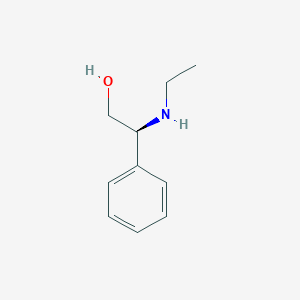
![2-Thiophenecarboxamide, 5-chloro-N-[(3R,5S)-5-(4-morpholinylcarbonyl)-1-[(1,2,3,4-tetrahydro-2-methyl-6-isoquinolinyl)carbonyl]-3-pyrrolidinyl]-](/img/structure/B3026709.png)
